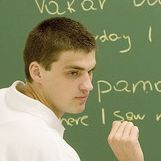Discovering the Structure of Lithuanian
Ten minutes before class is to begin, Laimis Kisielius
sits on a table outside Room 106 in Tucker Hall. Up walks Rob Simmons,
a senior from Arlington.
"Labas, Laimis," Simmons says.
"Labas!" Kisielius replies with a smile, and then turns to a third
party. "You see? They're learning." Which means Kisielius, William and
Mary's second-leading scorer this past basketball season, is doing his
job. The only Lithuanian student on campus, Kisielius is helping Jack
Martin's descriptive linguistics class learn the structure - but not
necessarily an overall understanding - of his native language.
"I'm not telling the kids how to do it," Kisielius said. "I'm just a
source for the language, as they say. It's mainly how to construct
sentences, and the kids are learning fast."
Kisielius is not the instructor - that would be Martin, an associate
professor of English whose focus is on language preservation. But every
semester, he tries to find someone on campus or in the community who
speaks an exotic language to work with his descriptive linguistic
students. In the past, they have studied Turkish, Tongan and Igbo
(Nigeria).
"The point of the class is to serve as a capstone course for
linguistics majors," Martin said. "They have to learn the techniques to
describe a language they've never learned or never heard before. They
have to figure out what sounds are important in a language and they
have to take it apart and figure out how the grammar works."
Kisielius, who is paid for his time, sits near the chalkboard. On this
particular day, he is asked to write some sentences in Lithuanian. Then
he is asked to translate them.
Vakar buvau muziejuje.
Yesterday I went to a museum.
Martin and his students discuss the grammar, the phonetics and the
orthography. Later, Kisielius is asked to write down some verbs so the
class can study prefixes and see how (or if) they are similar to other
languages. After several conjugations of faksuoti (to fax), Kisielius
surrenders. "I don't know what more you can do with a fax machine," he
said.
The atmosphere in the small classroom - 15 students, all but two of
them linguistics majors, are enrolled - is relaxed. Someone always
brings food to share, and on this beautiful Tuesday morning almost
everyone is wearing shorts.
Kisielius likes to joke around some, and that's encouraged. It's also
important that he fully understands what he's talking about.
"He studied a lot of Russian in addition to English, so he knows how
languages work and he knows the proper terminology," Martin said. "That
makes it really helpful."
The students also appreciate his approach.
"Laimis is a friendly giant," Dylan Goldblatt, a senior from Virginia
Beach, said of the 6-foot-8 Kisielius. "He's been a best friend to
everybody in the class. We all go out a lot after class and meet at
restaurants, and we talk about European soccer. He's just like the rest
of us - the only difference is that he speaks Lithuanian."














